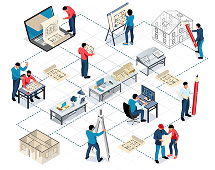Back
The Evolved Mechanical Engineer
Written by - Dheeraj Mathew Paulson From Abhiyantha May 06, 2025 5 Minutes
In the year 2025, do you wonder: who is the Mechanical Engineer? A relic of the Industrial Revolution of the late 1700s? A brilliant problem-solver who has unfortunately exhausted his usefulness with the onset of the post-modern era. Ever since that very first revolution, industry has continuously evolved to the point that we witness around us today. The Mechanical Engineer did not get left behind. He too has evolved. In fact, I would argue that he has been pivotal in catalyzing this evolution! Does this surprise you? It’s understandable. The reason being: the mechanical engineer of today resembles his forebears very little in an outward appearance.
You will not find the Mechanical Engineer of 2025 in greasy workshops and clammy industrial facilities. So where is he? He is envisioning the future, visualizing it as CAD in a digital environment and validating it using physics-based simulation. Once the vision takes shape with the boon of Additive Manufacturing, he studies it remotely by monitoring its digital twin in an immersive AR environment. He has deployed sensors on his product which provide real time feedback on its health using the Internet of Things. His comparison of the results of simulation and the prediction from historic data gives him more than fair certainty of exactly how his vision will play out in the real world. On a side note, you might wonder who has replaced him in the workshop? He has automated and optimized that process by the use of Robotics. He differs from your original mechanical engineer in more than just outward looks!
This changes your perception of the Mechanical Engineer, doesn't it! The internal combustion engine car was his brainchild, but today's autonomous electric car would not have become a reality without his involvement.
I have made references to multiple technologies in the previous paragraph. Let me break down each of those for you, so that you can appreciate their relevance better.
CAD
With the basics of Engineering Graphics and Design serving as his foundation, the Mechanical Engineer is using the latest CAD engines and generative design to digitally create the products of the future. CAD has become more fundamental to the product design and development process than ever before. Model Based Systems Engineering or MBSE is a new approach to product design where CAD dictates the entire process.
Simulation
You believe what you see. How does the Mechanical Engineer trust that his design will not fail when subjected to real world conditions? Physics-based simulations validate his design with an accuracy that is unparalleled today than ever before.
Additive Manufacturing
3D printing has made it possible to manufacture components that have been topologically optimized for their exact purpose thus creating a direct link between the Design and the Manufacturing processes. There is no wastage of material and the end product is lightweight as well as reliable.
Digital Twins
Today’s technology has made the engineer’s dream a reality. The ability to have a digital replica of your product while it is performing in the real world with access to its real time data integrated with simulation capabilities that will enable you to predict the behavior of individual components. This not only helps with predictive maintenance but allows you to optimize parts to outperform estimations.
AR
It’s always been challenging to visualize the final 3D product on a 2D screen. We have always been wondering when Tony Stark’s office will become a reality. Augmented Reality has paved the way for this revolution. The ability to overlay 3D digital objects in the real world. Where is the appeal for Mechanical Engineer? AR always begins with CAD. Sure, computer programming is indispensable. But that doesn’t intimidate him. He embraces that with equitable proficiency.
Internet of Things
The Internet of Things is what connects devices to the cloud and enables the communication of data. This is yet another technology that the Mechanical Engineer has embraced because it allows him to make better products which are smart and connected. Automation of systems, even mechanical ones, is facilitated by the Internet of Things.
Robotics
The question of the human workers’ safety has been a concern since work in hostile environments began. The Mechanical Engineer solves this problem by creating bots which fulfill specific purposes they are designed for. This is partially bad news for all of you who think you want to get your hands dirty. It's robots who have taken over that task and no wonder, humans cannot achieve that level of precision without the help of robots.
Robotics in itself has evolved over the years. One example of this would be soft robotics. Robots which redefine the traditional perception of these machines and open up new areas of exploration and implementation.
The question now goes out to all the aspiring Mechanical (and allied branches) Engineers out there who are reading this blog:
How well are you able to relate to this pioneering innovator?
Today's Mechanical Engineer is no less than that. He is a visionary who is shaping the future of humanity. He is pulling this off by not just having a deep understanding of engineering fundamentals but also his exceptional skills with cutting edge technology. It is important that engineering students pick up these skills in college. This will make you industry ready and an asset to society.
Are you ready to embrace this evolution?
At Abhiyantha, we are committed to providing you with the best training in the latest technologies. We have a team of experts who are ready to help you become the Mechanical Engineer. We offer a wide range of courses that cover all the latest technologies and trends in the industry.
For more insights and detailed discussions on this topic, you can visit PTC website

